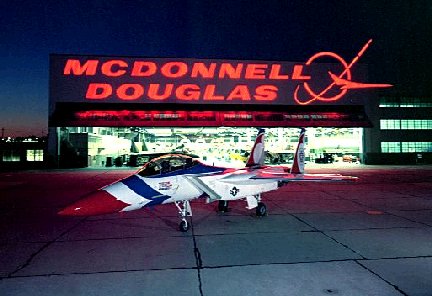|

"Still going"
F-15 Eagle Tactical
Fighter
The McDonnell Douglas F-15 Eagle, after more that 25 years of service, was still the
U.S. Air Force's premier fighter as the year 2000 approached. It is the only aircraft in the U.S. Air Force arsenal capable
of launching the ASAT anti-satellite missile. It also serves with the air forces of Israel, Japan and Saudi Arabia.
The F-15 constantly is upgraded to include state-of-the-art equipment. It can penetrate
enemy defenses and can outperform and outfight any current or projected enemy. The Eagle's air superiority is due to its advanced
avionics, its range and weaponry, and its unprecedented maneuverability. One person can effectively perform air-to-air combat
using its advanced systems to detect, acquire, track and attack enemy aircraft.
The F-15's low-wing loading (the ratio of aircraft weight to its wing area), combined
with its high engine thrust-to-weight ratio, allows it to turn tightly without losing airspeed. Under any light conditions,
data from the integrated avionics system is projected on the windscreen, so the pilot can track and destroy an enemy aircraft
without having to look down at cockpit instruments.
Between Jan. 16 and Feb. 1, 1975, an F-15A nicknamed "Streak Eagle" broke eight time-to-climb
world records. It reached an altitude of 98,425 feet just 3 minutes 27.8 seconds from brake release at takeoff and coasted
to nearly 103,000 feet before descending.
The first Eagle entered service in November 1974 with the 58th Tactical Training Wing
at Luke Air Force Base, Ariz. The first Air Force air defense squadron to transition to the F-15 was the 48th Fighter-Interceptor
Squadron at Langley Air Force Base, Va., in January 1982. By 1989, more than 1,200 Eagles were in service; most were built
by McDonnell Douglas in St. Louis, and more than 110 were built by Mitsubishi of Japan.
The single-seat F-15C and two-seat F-15D models were followed by the two-seat, dual-role
F-15E "Strike Eagle," the world's most technologically advanced fighter. With increased payload capacity, the F-15E flew for
the first time on Dec. 11, 1986. The F-15E "Strike Eagle" can fly higher than 50,000 feet at more than Mach 2.5. It can fly
air-to-air, air-to-ground, long-range, day or night missions, in any kind of weather.
Specifications
| First flight: |
July 27, 1972 |
| Wingspan: |
42 feet 10 inches |
| Length: |
63 feet 9 inches |
| Height: |
18 feet 8 inches |
| Ceiling: |
65,000 feet |
| Range: |
2,400 miles |
| Weight: |
68,000 pounds |
| Power plant: |
Two 25,000-pound-thrust P&W F100-PW-100 turbofan engines |
| Speed: |
1,875 mph |
| Accommodation:
|
F-15A/C, 1 crew; F-15B/D, 2 crew |
| Armament: |
AIM-7F/M Sparrow missiles or AIM-120 advanced medium-range
air-to-air missiles; AIM-9L/M Sidewinder or AIM-120 missiles; 20 mm Gatling gun. |

|